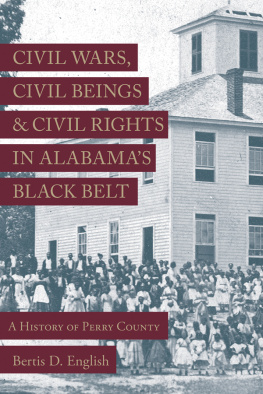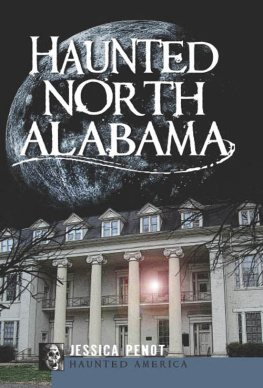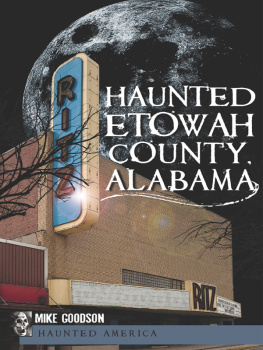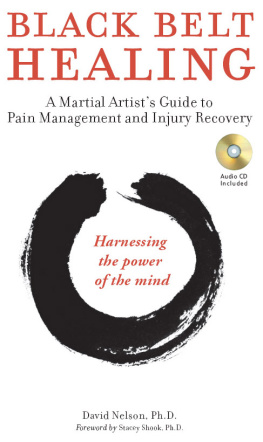
Published by Haunted America
A Division of The History Press
Charleston, SC 29403
www.historypress.net
Copyright 2013 by David Higdon and Brett Talley
All rights reserved
Cover image: Front view of Brownstone Manor. Courtesy Faith Serafin.
First published 2013
e-book edition 2013
Manufactured in the United States
ISBN 978.1.61423.992.5
Library of Congress Cataloging-in-Publication Data
Higdon, David, 1966-
Haunted Alabama Black Belt / David Higdon and Brett Talley.
pages cm
Includes bibliographical references.
print edition ISBN 978-1-60949-944-0 (paperback)
1. Ghosts--Alabama--Anecdotes. 2. Ghosts--Black Belt (Ala. and Miss.)--Anecdotes. 3. Haunted places--Alabama--Anecdotes. 4. Haunted places--Black Belt (Ala. and Miss.)--Anecdotes. 5. Alabama--Social life and customs--Anecdotes. 6. Black Belt (Ala. and Miss.)--Social life and customs--Anecdotes. 7. Alabama--History, Local--Anecdotes. 8. Black Belt (Ala. and Miss.)--History, Local--Anecdotes. I. Talley, Brett J. II. Title.
BF1472.U6H527 2013
133.1097614--dc23
2013032987
Notice: The information in this book is true and complete to the best of our knowledge. It is offered without guarantee on the part of the authors or The History Press. The authors and The History Press disclaim all liability in connection with the use of this book.
All rights reserved. No part of this book may be reproduced or transmitted in any form whatsoever without prior written permission from the publisher except in the case of brief quotations embodied in critical articles and reviews.
Kathryn Tucker Windham,
the American storyteller
June 2, 1918June 12, 2011
CONTENTS
ACKNOWLEDGEMENTS
The authors would like to thank the innumerable people who helped to make this book possible, from the people who agreed to share their stories to the friends and family members who supported us throughout the process of writing the book. We couldnt have done it without you, and this book is truly as much a testament to you as it is to us.
Still, some people deserve special recognition. David would like to thank his wife, Debbie, who has stood beside him through good times and bad, and his four children, who have inspired him to pursue this project.
As for Brett, he would like his parents, Mike and Sue Talley, to know that this book is for them. They inspired his love of history and his desire to always seek the truth. He would be nothing without them, and this book is but one part of his life that he was only able to accomplish because of their love. Brett would also like to dedicate this book to his nephew, Cristian. Read, learn and remember.
Both authors would like to give a special thanks to Faith Serafin, the author of the wonderful Haunted Auburn and Opelika, Haunted Columbus, Georgia: Phantoms of the Fountain City and Haunted Montgomery: Ghost Stories from the Heart of Dixie. Faiths knowledge of the haunted history of Alabama is matched only by her kindness and willingness to help us in our efforts. We could not have done this without her.
A view of the Alabama Black Belt.
INTRODUCTION
There is a place in Alabama, a region that stretches across its lower-middle, from Georgia to Mississippi. It is a place steeped in historya place where a people were enslaved, a nation broken and a new dream of freedom born. It is a place where the past is always near at hand. Sometimes, that past takes a moment to whisper in your ear. They call this place the Black Belt.
In 1814, forces under the command of Andrew Jackson defeated an alliance of Creek Indians, opening much of the territory of Alabama to settlement. And come the settlers did. When they poured across the Appalachian Mountains and made their way down to the plains of the South, to the flat fields that stretch all the way to the sea, the new inhabitants of the state discovered something unusual. The soil was different here. Instead of the red clay that characterizes the northern part of Alabama, the farmers found a thin layer of dark, rich earth. From that soil would grow massive fortunes, a war that would cost hundreds of thousands of lives and a movement that would set a people free.
Everyone knows that cotton was king in the antebellum South, and nowhere was that more true than the Black Belt of Alabama. With deep wells to provide needed water, mighty mansions rose throughout the region, engaging thousands of African slaves to grow the crop that made the owners of those plantations wealthy and powerful. They used that wealth and power to ensure that on January 11, 1861, Alabama followed South Carolina, Mississippi and Florida in seceding from the Union. So iconic was the Black Belt in the antebellum South that Montgomery, the city at the heart of the region, was declared the capital of the new nation. The Buckle of the Black Belt had become the Cradle of the Confederacy.
The war that followed didnt quite go the way the men and women of lower Alabama might have expected. The Black Belt was spared much of the suffering of the rest of the South, though, and by the time Farraguts fleet entered Mobile and Union soldiers started making their way north, the war was all but over. With the conflicts end, a group of people was free and a way of life shattered. But while slavery passed away, the worlds thirst for cotton did not ebb, and the millions of newly freed slaves needed employment. Sharecropping was born, a system that bound the poorboth black and whiteto the land almost as tightly as the chains of slavery had previously. A place named for its soil would keep its moniker because of the people who worked it. And the system of racial discrimination that grew up around the region set up the next great battle for freedom and equality.
For nearly one hundred years, that systemknown as Jim Crowheld sway. Then, on December 1, 1955, four African Americans were sitting on a crowded afternoon bus in downtown Montgomery. The driver asked them to get up so that white riders could have their seats. Three of them complied. One of them did not. When the police arrested Rosa Parks, they could not have known that it was the beginning of the end of segregation.
The fight for racial equality was waged as much in the Black Belt as anywhere else in America. It was here where the Montgomery Bus Boycottspurred by Rosa Parkss act of courageended discrimination against blacks in public transit. It was here where Freedom Riders, including members of President John F. Kennedys Department of Justice, were beaten by angry mobs opposed to integration. It was here where protestors, led by Martin Luther King Jr., marched from Montgomery to Selma seeking the right to vote. And it was here where brave men and womenblack and white, northern and southernjoined forces to ensure that institutionalized racism and discrimination would forever be consigned to the dustbin of history.
In a place like that, a place that has seen so much history, struggle and suffering, as well as so many tears and triumphs, is it any surprise that there are those who believe that some events are burned forever into the very fabric of the Black Belt? Stories abound of cemeteries where the dead do not sleep, of courthouses haunted by the unjustly accused, of plantations with ghosts as thick as cotton, of libraries that retain more than old books and of hotels where the guests never check out. In Alabamas Black Belt, the nights are heavy with the past, and history sometimes finds its way into the present.












